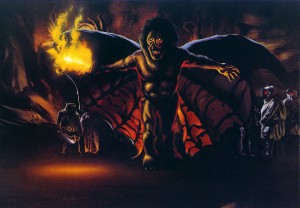
The lion-headed creature with the body of an ape, butterfly wings plus a whip and flaming sword remains one of the classic renditions of Tolkien’s monster — whether for better or worse is up to you.
If you haven’t seen it before, or would like to refresh your memory, just check the clip below.
However, your memory might be hazier of the scene where Gandalf describes his battle through the fall in Moria’s abyss and on the Endless Stair to Aragorn, Legolas and Gimli. That’s because at this point Bakshi used a pastiche of highly stylistic still images that cut back and forth. The entire sequence lasts a bare 30 seconds. We never truly see the Balrog of Moria in its worm form.
The good news is that Ralph Bakshi actually began animating that sequence in full but it never made the final cut. The even better news is that his son, Eddie, who has been selecting and restoring scenes that ended up on the cutting room floor has rescued the original sequence from quiet oblivion and you can now see the result for yourself.
Gandalf recalls fighting the Balrog. Thirteen second clip by Ralph Bakshi.
Gandalf duels with the Balrog and smashes into the endless staircase. Ten-second clip by Ralph Bakshi.
Boing Boing writer and TORn contributor Ethan Gilsdorf contacted Ralph Bakshi to ask about the restored clips and why they never made the final cut:
“If you’re getting close to delivery, it’s better to cut the animation out to make the scene work, than racing to reanimate it to make the cut work,” Bakshi said, recalling the hectic atmosphere as the film’s deadline loomed.
Asked why Gandalf and the Balrog look quite different in these new scenes, compared to the rotoscoped Gandalf and Balrog seen on The Bridge of Khazad-dûm, Bakshi said, “Well, it’s hazy, but I was trying to make memories different than the real time story. I was wrestling with trying to separate the styles.”


